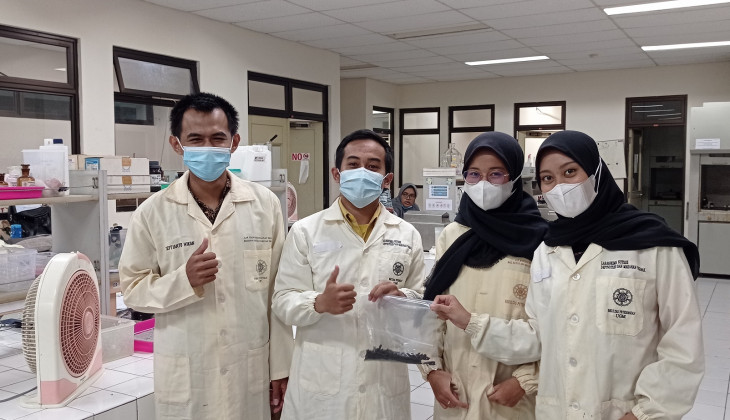One of the environmental problems, especially in Indonesia, is The increase in greenhouse gases (GHG). Most of the methane gas that accumulates in the atmosphere comes from the agricultural sector, especially livestock. Data from the Central Statistics Agency states that the number of beef cattle in Indonesia as of 2020 reached 17,466,792 heads with methane gas emissions of around 45.5 kg/head/year. Feeding with more forage than concentrate causes higher methane production in ruminant enteric fermentation.
Considering these problems, the UGM student team innovated animal feed nano-biochar pellets to reduce methane gas emissions in cattle. The four students include Agung Rizky Fauzi (Animal Science 2018), Muhammad Maulana Sadid (Animal Science 2018), Aulia Tegar Luh Azzahra (Veterinary Medicine 2019), Arifah Maharani Crishna Fadzilah (Chemistry 2019), and Arifa Zaini Syafhira (Animal Husbandry 2020). They conducted research on producing nano-biochar pellets as feed additives for animal feed.
According to Agung Rizky Fauzi, the head of the research team, nano-biochar pellets can be used as feed additives for ruminant feed. They can reduce the production of methane gas in the enteric fermentation process for livestock. Fermentation of organic compounds in the feed will produce Volatile Fatty Acid (VFA), carbon dioxide (CO 2 ), hydrogen gas (H 2 ), and several microbes. “The accumulation of these gases in the rumen stimulates methanogenesis, which produces methane gas,” explained Agung.
Maulana Sadid, a member of the research team, stated that the ingredients in the pellets were tannins. Tannins reduce methane levels in ruminants by protecting the protein. Thus, it cannot be used by methanogenic bacteria or methane-producing bacteria. In addition to these ingredients, there are also two other ingredients, essential oil and biocarbon, which serve as antimicrobials or volatile substances that can reduce rumen microbial activity, especially protozoa and methane-producing methanogens. Meanwhile, biocarbon functions as an adsorbent for methane or CH4 by changing the rumen microbial biofilm and increasing rumen methanotrophs, which is a bacteria that use methane as a carbon and energy source.
The potential of Nano-Biochar Pellets to reduce methane gas is the result of the rumen microbial fermentation process through the addition of tannins, essential oils, and biochar. Besides reducing emissions, this feed can also increase the absorption of nutrients from feed by livestock so that it can be maximized and affects the productivity of the livestock itself. “Judging from the potential of the three additional feed ingredients for livestock, Maulana said, it is expected to reduce the production of exhaust gases, especially methane gas,” he said.
Their supervisors, Prof. Lies Mira Yusiati and Dr. Muhsin Al Anas, said that research on the development of Nano-Biochar Pellets as a Feed Additive in Animal Feed is an innovation that can be mass-produced. It is expected to be utilized by farmers and the community and has economic value as well.



